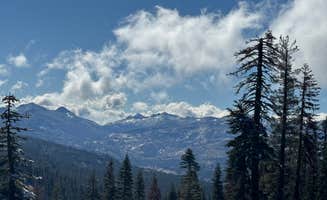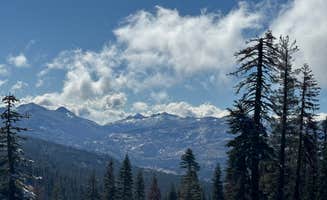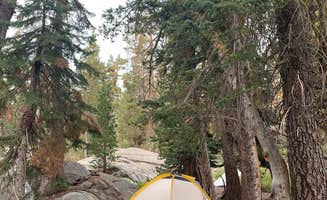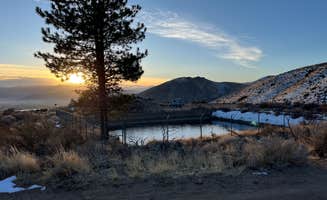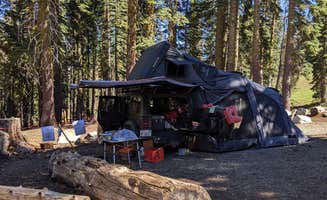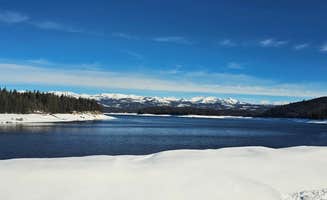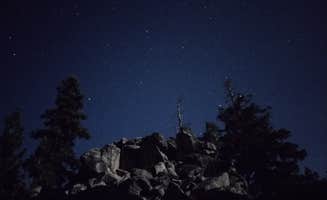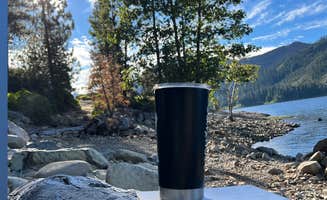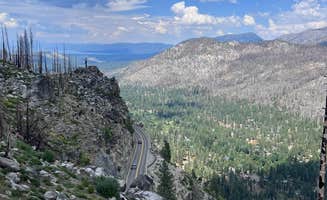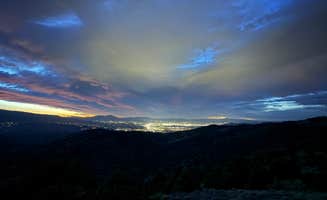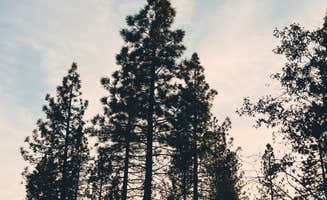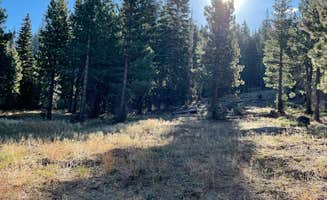Primitive camping near Olympic Valley, California provides access to high-elevation terrain between 6,000-8,000 feet, with notable temperature swings even during summer months. Many dispersed sites sit along forest service roads requiring significant ground clearance, with several becoming impassable after rainfall or during early season snowmelt. Snow can linger at higher elevations well into June, affecting accessibility to popular backcountry sites.
What to do
Hike to alpine lakes: Loch Leven Lakes offers multiple interconnected lakes accessible via a moderately difficult trail. "We backpacked up to the high loch levens lake where we found many available campsites. But also a lot of the nice view spots were occupied since we didn't start our hike up early, we started at 5:30pm. The middle lake is very large and had many beautiful spots to camp," notes camper Azizah T.
Winter camping adventures: Lake Valley Road Pullout provides access to snowy terrain for cold-weather enthusiasts. However, preparation is essential as one camper warns: "Got stuck for over a day trying to get to the site. Tow truck also got stuck. Would not recommend coming until spring."
Visit fire lookout towers: Grouse Ridge Campground includes access to a historic fire lookout with panoramic views. "Several camping spots. Numerous lakes to hike and a lookout tower with great views," shares Casandra E.
Fishing opportunities: Several lakes near dispersed sites offer fishing potential with relatively light pressure. Mountain trout are common targets, particularly during early morning hours when water temperatures are cooler.
What campers like
Temperature relief: Higher elevations provide natural air conditioning during hot valley months. "It was 25 degrees cooler up there than in Sacramento. We loved this campground. I can't wait to go back," says Linda L. about her experience at Grouse Ridge.
Solitude on weekdays: Mid-week camping typically offers significantly more privacy and choice of sites. "We went mid week in August and it wasn't too crowded. The views were beautiful and the water was perfect," reports Har Rai K.
Lakeside camping options: Bowman Lake Dispersed camping provides direct water access. "If you are looking to be near the water and no service, this is perfect. The rough road in I believe must keep some folks out but the lake is amazing," notes Shawn M.
Wildlife viewing: Campers frequently spot deer, various bird species, and occasionally black bears. Proper food storage is essential at all primitive camping locations.
What you should know
Road conditions vary significantly: Many sites require high-clearance vehicles or 4WD. At Kyburz Flats, "Road is rough, especially after first mile to interpretive site. Looks like a few spots there you could camp. The last mile gets rougher. Was fine in my 2wd van but have high clearance and was dry," reports Greg C.
Weather unpredictability: Mountain weather changes rapidly regardless of forecasts. One camper at Granite Chief Wilderness noted: "It rained when we got here… which over night at some point turned into the first snow!!! How insanely beautiful!"
Insect activity: Mosquitoes can be problematic, particularly near water sources. "I will say that there was a lot of mosquitos. Even with bug spray I left with 7 bites," warns a Loch Leven Lakes visitor.
Permit requirements: Some areas require permits for overnight stays, particularly within Tahoe National Forest boundaries. Check current regulations with ranger districts before departure.
Pack out all waste: No garbage services exist at primitive sites. Campers must pack out everything they bring in.
Tips for camping with families
Best sites for children: Scotts Lake Rd Dispersed Camping offers relatively flat terrain and some sites with natural boundaries. "Easy to see right off the road with plenty of campsites down either side of a nice dirt road. Rocky and steep road access to Scott's lake, but easy camping on the edge of the valley," says Austin M.
Water safety considerations: Lakes in the region remain cold even during summer months. Children should be supervised near water as shorelines can drop off quickly.
Bring additional layers: Even summer nights drop into the 40s at higher elevations. Pack extra warm clothing for children regardless of season.
Wildlife awareness: Teach children proper food storage and garbage management to minimize animal encounters. Bear-resistant containers are recommended at all primitive sites.
Tips from RVers
Large rig access points: Some dispersed areas can accommodate larger vehicles with careful navigation. "We are new to dispersed camping and have a 40 ft 5th wheel as well as a GMC Denali 350 dually. We need a large space to fit into. We arrived on a Monday at noon and found that the large area about 1/4 mile in was not at all crowded," shares Susan L. about Scotts Lake Road.
Weekday arrival recommended: Weekend crowds can make navigating tight forest roads challenging with larger vehicles. Arriving Monday through Thursday provides better site selection.
Level site scarcity: Bring adequate leveling equipment as truly flat sites are uncommon. Most require some adjustment, particularly for larger rigs.
Road reconnaissance: When possible, scout roads without your trailer before attempting access. Several campers recommend unhitching at wider areas to investigate site suitability before committing to narrow roads.


